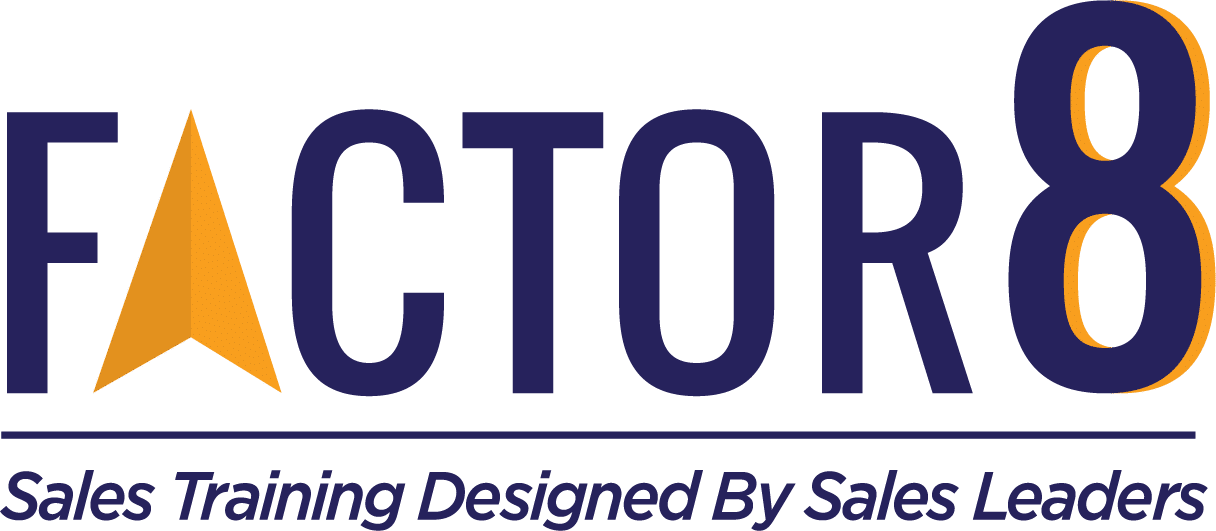
Sales Team Challenges

Sales Manager Fears, Fails, and Fixes: Fast Actions to Prevent Burnout & Failure! [Webinar Recording]
Sales Manager Fears, Fails, and Fixes: Fast Actions to Prevent Burnout & Failure!
[Video Recording]
Why Your Sales Team Isn’t Hitting Quota (And What to Do About It) [Webinar Recording]
Why Your Sales Team Isn’t Hitting Quota (And What to Do About It)
[Video Recording]
Meet the Speakers

Lauren Bailey
Founder
Factor 8 & #GirlsClub
Lauren Bailey, known to many as “LB”, is a sales leader, enablement leader, and entrepreneur and founder of 3 successful brands: Factor 8, providing front-line job training for inside sellers and managers, The Sales Bar, a subscription-based virtual sales training platform, and #GirlsClub, a community and development program helping more women earn leadership positions in sales.

Lori Richardson is a sales process and leadership expert who helps mid-sized company leaders build top sales teams through the right people, processes, pipeline and leadership moves. Lori is a sales coach at Harvard Business School for their MBA students, hosts an award-winning podcast, and is author of “She Sells – Find, Hire, and Retain Great Women in B2B Sales” Founder of Score More Sales, you can find her @scoremoresales on most social platforms.
Join Another Sales Shot
View our live Sales Shot webinar schedule and register for upcoming events below.
Strategies for Proving ROI in Revenue Enablement [Webinar Recording]
Strategies for Proving ROI in Revenue Enablement
[Video Recording]

How Do Logistics Companies Adapt Sales Strategies Amid Global Challenges?
Logistics companies must strategically evolve their sales approaches when facing unprecedented challenges. As the world experiences geopolitical shifts, economic uncertainties, and digital transformation, logistics companies must adeptly deal with these complexities to sustain and grow their businesses. This demands understanding emerging market trends, integrating cutting-edge technologies into logistics strategies, and proactively responding to changing consumer behaviors.
In this context, let’s discuss a few examples of how logistics companies adapt sales strategies amid global challenges and recalibrate their methods to effectively meet the demands of the modern market.
READ: 6 Logistics Sales Tips to Master Phone Selling
Key Takeaways
- Logistics companies face unprecedented geopolitical shifts, economic uncertainties, and digital transformations. To thrive, they must understand emerging market trends, integrate cutting-edge technologies, and respond proactively to changing consumer behaviors.
- Volatile markets demand adaptive strategies and resilient decision-making. Logistics companies must navigate economic uncertainties by staying agile, making strategic decisions, and optimizing operations to thrive in unpredictable landscapes.
- Economic uncertainties directly impact consumer spending, influencing logistics demand. Companies must remain flexible, efficiently manage supply chains, and be prepared to handle fluctuations in workload, ensuring resilience in uncertain economic times.
Understanding Global Challenges
Dealing with complicated global challenges requires a comprehensive understanding of the complex factors shaping our world. From geopolitical tensions and economic fluctuations to environmental concerns, let’s look into the various global challenges, offering insights into their origins, impacts, and potential avenues for effective resolution.
Economic Uncertainties
Businesses struggle with volatile markets and changing paradigms amid economic uncertainties. Navigating these challenges demands adaptive strategies and resilient decision-making to thrive in an unpredictable landscape.
Impact On Consumer Spending And Demand For The Logistics Industry
Economic uncertainties affect people’s spending, impacting the whole inbound logistics industry. When people are unsure about the economy, they spend less. This makes logistics companies rethink their plans to save money and work better. The demand for moving goods around also goes up and down.
So, these companies must be flexible and smart in managing their supply chains. They have to find ways to be efficient while being ready to handle more or less work quickly. This helps them stay strong and responsive, even in an uncertain economy.
Currency Fluctuations And Their Effects On Pricing
Currency fluctuations play a pivotal role in shaping pricing dynamics. When a country’s currency value shifts, it impacts the cost of imported goods and production inputs. For businesses dealing with international trade, these changes can lead to unpredictable costs, affecting pricing strategies. A weaker currency can make exports more competitive but might squeeze profit margins.
Adaptable pricing mechanisms become crucial for businesses to absorb currency-related shocks, ensuring competitiveness and financial stability in the face of ever-changing exchange rates. Balancing these factors is vital for sustained market presence.
WATCH: 10 Virtual Sales Tips Guaranteed To Add Faster Revenue [FreightWaves]
Supply Chain Disruptions
Supply chain disruptions, unforeseen and impactful, pose significant challenges to businesses worldwide. Whether triggered by natural disasters, global events, or logistical hurdles, these disruptions can ripple through industries, affecting production, inventory, supply chain visibility, and customer satisfaction.
Impacts Of Geopolitical Tensions On Supply Chain Management
Geopolitical tensions, like conflicts between countries, can affect how things are moved and made globally. Tariffs and trade issues can make getting the stuff needed for business harder, leading to more costs, delays, and shortages.
To handle this, companies should use different suppliers, be flexible in moving things, and monitor political situations. Planning for these risks is crucial to keeping supply chain actions running smoothly. Understanding what’s happening between countries helps businesses be ready and resilient in the face of these challenges in their supply chains.
Natural Disasters And Their Influence On Logistics Operations
Unfortunately, natural disasters, such as earthquakes or floods, disrupt supply chains. They hinder the transportation of trucks and deteriorate roadways, making it difficult to deliver goods on schedule. Companies must quickly find new ways to send stuff, deal with insufficient products, and keep their workers safe.
After the disaster, they might need to help deliver things to needy people. Being ready for these problems by checking risks, using different suppliers, and having backup plans. With more and more bad weather happening, companies always need to stay ahead and be ready to adjust their plans to keep things working okay.
Technological Advancements
In the era of rapid innovation, technological advancements are transforming how we live and work. From the breakthroughs in artificial intelligence to the seamless integration of smart devices, let’s explore the dynamic landscape of technological progress and its profound impact on shaping our present and future.
Digital Technologies In The Logistics Industry
Digital technologies are changing how the logistics system works. Things like computers, data analysis, and smart devices make moving goods faster and cheaper. Tools track shipments, improving routes and reducing delays. Using the Internet to share information helps everyone work together.
Smart machines predict what will happen, making it easier to plan. Connecting online shopping with shipping makes delivering orders faster. These tech changes improve the logistics process, help the industry stay flexible, and grow in our modern and tech-driven world.
The Rise of E-Commerce And Its Implication For Logistics Sales
The rise in e-commerce is changing how things are bought and sold, significantly affecting logistics sales. The increasing popularity of online shopping has led to a greater need for dependable and effective logistics services. Logistics companies must adapt by integrating advanced technologies and logistics functions, optimizing last-mile delivery, and bolstering warehouse capabilities.
The growth of online businesses demands a customer-centric logistics strategy that prioritizes openness and adaptability. Meeting the changing demands of online platforms, maintaining a smooth supply chain, and taking advantage of the growing opportunities given by the digital marketplace are now critical components of successful logistics sales.
DOWNLOAD: Top Virtual Sales Challenges [INFOGRAPHIC]
Adapting A Sales Strategy
In a dynamic landscape, businesses must flexibly respond to shifting consumer behaviors, emerging technologies, industry events, and market trends, ensuring resilience and sustained success in a rapidly changing environment.
Embracing Digital Transformation
In the era of rapid technological evolution, embracing digital transformation is key to staying relevant and competitive.
Leveraging Technology For Efficient Sales Process
Using technology effectively is essential for a successful sales process. Customer relationship management (CRM) systems streamline communication, track interactions, and optimize lead management.
Automation tools facilitate personalized communication and nurture leads at scale. Advanced analytics provide insights into customer preferences, aiding targeted selling strategies. E-commerce integration enables seamless transactions, while AI-driven chatbots enhance customer support. Mobile platforms empower sales teams to operate flexibly.
By leveraging these technologies, companies increase productivity, decrease expenses, and develop a customer-centric approach and responsive sales ecosystem, giving them a competitive advantage in today’s tech-driven market.
Implementing E-Commerce Platforms and Online Sales Channels
Integrating e-commerce websites, online platforms, and online sales channels is transformative for businesses. Establishing a robust online presence facilitates global reach and 24/7 accessibility. E-commerce platforms streamline transactions, ensuring a seamless and secure customer shopping experience.
Utilizing online sales channels, such as social media and marketplaces, expands visibility and diversifies revenue streams. Responsive websites and mobile optimization enhance end-user experience. Leveraging predictive analytics also provides valuable insights into customer behavior, aiding targeted marketing.
Businesses can increase market reach and adjust to changing consumer preferences by utilizing various digital distribution channels, which promotes growth and competitiveness in the ever-changing world of online commerce.
Diversification Of Services
Embracing diversification in services is a strategic move for businesses navigating today’s dynamic markets. Know the importance of expanding offerings to meet diverse consumer needs, fostering adaptability, mitigating risks, and ensuring sustained growth in an ever-evolving business landscape.
Expanding Service Levels To Meet Changing Market Demands
Businesses need to adapt their services as market demands change to stay competitive in the industry. It means offering what customers order, whether personalized experiences or quick customer support. By being flexible and paying attention to people’s needs, companies can keep customers happy and grab new opportunities in the evolving market.
Specialized Solutions For Niche Markets and Industries
Creating specialized solutions for niche markets means customizing products or services to meet specific needs in particular industries or customer groups. This approach helps businesses stand out by addressing unique challenges and opportunities.
It allows companies to build expertise and establish a competitive edge in markets with specific demands. Providing tailored solutions is an effective way for businesses to differentiate themselves and succeed in industries where one-size-fits-all offerings may not suffice, fostering long-term success and customer satisfaction within these specialized markets.
Agility and Flexibility
Agility and flexibility are essential for success in the dynamic business world. Understanding how businesses navigate change, seize opportunities, and respond promptly to evolving demands positions themselves for resilience and sustained growth in dynamic environments.
Creating Flexible Sales Structures To Respond To Dynamic Market Conditions
Creating flexible sales structures involves strategic design to respond swiftly to dynamic market conditions. Start by understanding evolving consumer needs and monitoring market trends. Develop an adaptable framework that allows quick adjustments to pricing offerings and sales strategies. Embrace technology for real-time data analysis to inform decision-making. Foster a culture of agility within the sales team, encouraging proactive responses to changing market dynamics.
Regularly assess and refine the sales structure based on performance metrics and customer feedback. This approach ensures that businesses remain responsive, capitalize on emerging opportunities, and effectively navigate the complexities of a dynamic market environment.
Building Adaptive Pricing Models
Building adaptive pricing models requires a strategic approach. Analyze market dynamics, considering demand, competition, and economic trends. Implement data-driven insights to identify optimal pricing points and incorporate flexibility to adjust in real time.
Embrace dynamic pricing algorithms that respond to changes, ensuring competitiveness. Tailor pricing structures to diverse customer segments, balancing value proposition and affordability. Regularly assess and refine models based on performance and market shifts.
Incorporate customer feedback to enhance pricing strategies. Businesses can cope with changing market environments, maximize income, and remain flexible in reacting to changing customer behavior and market situations by continuously adapting corporate strategy.
Customer Relationship Management (CRM)
Customer Relationship Management (CRM) is a pivotal strategy in modern business. From tracking interactions to enhancing personalized experiences, CRM is vital in fostering customer loyalty and driving sustainable business growth.
Utilizing CRM Systems To Enhance Customer Interactions
Leveraging CRM systems is critical to enhancing customer interactions. Begin by centralizing customer data to gain a comprehensive view. Use this information to personalize interactions, addressing individual needs and preferences. Implement automation for timely follow-ups, ensuring consistent engagement. Analyze customer behavior data to anticipate needs and tailor offerings.
Share customer insights within the CRM platform to encourage collaboration across teams. Update and maintain data accuracy regularly for effective decision-making. By utilizing CRM systems adeptly, businesses can build stronger relationships, improve communication, and create a customer-centric approach that fosters loyalty and satisfaction in today’s competitive market landscape.
Personalizing Sales Approaches Based On Customer Needs
Personalizing sales approaches involves understanding and responding to individual customer needs. Start by collecting and analyzing customer data to gain insights into preferences and behaviors. Tailor communication and product recommendations accordingly.
Utilize CRM systems for a centralized view of customer interactions, ensuring a seamless channel for customer experience throughout. Implement targeted marketing strategies that address specific needs and concerns. Foster open communication, encouraging feedback for continuous improvement. Regularly assess and adjust sales techniques based on customer responses.
Collaborative Approaches
Collaborative approaches stand as a cornerstone in today’s interconnected business landscape. From cross-functional teamwork to strategic partnerships, this approach cultivates innovation, accelerates problem-solving, and ensures collective success in navigating the complexities of modern industries.
Collaborating With Other Logistics Companies For Network Expansion
Collaborating with other logistics companies for network expansion requires strategic partnerships and shared goals. Begin by identifying compatible partners with complementary strengths. Establish transparent communication channels and define mutual objectives.
Implement technology solutions for seamless information exchange and coordination. Develop standardized processes to enhance interoperability. Foster a culture of collaboration among teams through joint training and knowledge sharing.
Review the partnership’s performance and adapt strategies as needed. By working together, logistics companies can create a robust network, optimize resources, enhance service capabilities, and capitalize on collective strengths to navigate the challenges and opportunities of the ever-evolving logistics industry.
Strategic Partnerships With Technology Providers For Innovation
Forming strategic partnerships with technology providers for innovation involves careful planning. Identify providers whose solutions align with your business goals. Establish clear communication channels and shared objectives. Collaborate on research and development to create innovative solutions.
Leverage their technological expertise to enhance your products or services. Foster a symbiotic relationship that benefits both parties. Regularly evaluate and adapt the partnership to evolving needs. Embrace a culture of continuous learning and collaboration. Through these strategic alliances and strong relationships, businesses can stay at the forefront of innovation, drive competitiveness, and capitalize on emerging technologies to meet the dynamic demands of the market.
Incorporating Sustainability In Sales Strategies
Integrating sustainability into sales strategies requires a holistic approach. Begin by aligning products or services with eco-friendly practices. Communicate transparently about sustainable initiatives to build customer trust. Implement green supply chain practices and choose eco-friendly packaging. Educate sales teams to articulate the environmental benefits of offerings.
Establish partnerships with sustainable suppliers. Integrate sustainable practices into marketing materials and campaigns. Leverage certifications to validate sustainability claims. Regularly assess and improve sustainability efforts. By incorporating eco-conscious elements into sales strategies, businesses appeal to environmentally-conscious consumers and contribute to a more sustainable and responsible marketplace.
Addressing Environmental Concerns To Attract Socially Responsible Clients
Addressing environmental concerns to attract socially responsible clients involves strategic initiatives. Start by transparently communicating eco-friendly practices in products and operations. Obtain and showcase relevant certifications.
Integrate sustainable practices into marketing materials. Support environmental causes and share these efforts with the community. Collaborate with eco-friendly partners and suppliers. Implement green packaging and supply chain solutions.
Educate clients on the positive environmental impact of their choices. Continually assess and improve sustainability efforts. By actively addressing environmental concerns, businesses can attract socially responsible clients and contribute to a more sustainable and conscientious business ecosystem.
WATCH: Sales Enablement Secrets: Actionable Sales Training Tips, Trends, And Advice
Talent Development and Sales Training
Talent development and sales training are critical pillars of organizational growth. From honing individual capabilities to fostering a culture of continuous learning, talent development, and training are key elements in achieving sustained success in dynamic industries.
READ: Why Event-Based Sales Training Falls Short
Training Sales Professionals On New Technologies And Trends
Training sales professionals on new technologies and trends involves a strategic approach. Begin by assessing skill gaps and identifying relevant technologies. Implement interactive and hands-on training sessions. Provide access to online resources and simulations.
Foster a culture of continuous learning through workshops and seminars. Encourage collaboration and knowledge-sharing among sales teams. Stay updated on emerging trends to adapt training content. Leverage e-learning platforms for flexibility.
Offer incentives and recognition for skill development. Regularly evaluate training effectiveness and refine programs as needed. By keeping sales teams abreast of technological advancements, businesses ensure adaptability and competitiveness in a rapidly evolving market.
READ: How to Measure Sales Training ROI
Developing A Customer-Centric Mindset Within The Sales Force
Developing a customer-centric mindset within the sales force requires a cultural shift. Start by emphasizing the importance of customer satisfaction in training programs. Encourage active listening and empathy during customer interactions.
Foster a collaborative approach, aligning sales goals with customer needs. Provide tools and resources that prioritize customer insights. Recognize and reward customer-centric behavior. Implement feedback loops to improve customer engagement continuously.
Integrate customer feedback into sales strategies. Cultivate a company-wide commitment to customer satisfaction. Using customer expectations and a customer-centric mindset, sales teams can build stronger relationships, enhance loyalty, and contribute to sustained business success in today’s customer-focused market.
Understanding And Adapting To Diverse Global Markets
Understanding and adapting to diverse global markets is crucial for business success. Conduct comprehensive market research to grasp cultural nuances, preferences, and economic trends.
Tailor marketing strategies to resonate with local audiences, considering language, customs, and values. Establish partnerships with local experts to navigate regulatory landscapes. Utilize technology for effective communication and market outreach.
Be agile in adapting products or services to meet specific market needs. Embrace diversity within the organization to foster cultural intelligence. Continuously monitor and respond to evolving market dynamics. Businesses can build resilience and thrive in a globally interconnected world by navigating the intricacies of diverse global markets.
Incorporating Cultural Intelligence In Sales Approaches
Incorporating cultural intelligence in sales approaches is pivotal. Start by fostering cultural awareness through training programs. Encourage active listening to understand diverse customer perspectives. Adapt communication styles and content to resonate with different cultures.
Employ sales teams that represent diverse backgrounds for a nuanced approach—leverage technology for language translation and cross-cultural communication. Respect cultural norms and etiquette in business interactions.
Collaborate with local experts for market insights. Continuously educate sales professionals on global trends and cultural shifts. By embracing cultural intelligence, businesses can build trust, establish meaningful connections, and tailor sales strategies that resonate authentically with diverse audiences in a globalized market.
Final Thoughts
In conclusion, logistics companies must adapt sales strategies amid global challenges for sustained success. Navigating geopolitical shifts, economic uncertainties, and digital transformation demands a proactive and flexible approach.
Logistics firms can thrive in the face of complexity by embracing innovative sales methodologies, integrating cutting-edge technologies, and staying attuned to emerging market trends. Their ability to recalibrate strategies, foster agility in supply chain management, and address changing consumer behaviors positions them for resilience.
In this dynamic landscape, the evolution of sales email marketing strategies becomes a necessity and a strategic imperative for supply chain process logistics companies to thrive amidst global challenges.
About the Author:

Diana leads the growth marketing initiatives at Stallion Express. As a personal trainer turned digital marketer, Diana is obsessed with equipping eCommerce entrepreneurs with everything they need to scale their online businesses. You can catch her doing yoga or hitting the tennis courts in her spare time.
Subscribe to our email list to receive new content, webinar invites, and training offers.
8+ Critical Things Sales and Enablement Leaders Need to Know About AI [Webinar Recording]
8+ Critical Things Sales And Enablement Leaders Need To Know About AI
[Video Recording]

Why You Need a Sales Training and Enablement Budget for 2024
Tons of amazing sales trainers and enablement folks fell victim to RIFs because of this year’s slow economy.
It’s unfortunate, but not surprising, right? We all know that when companies cut spending, training is one of the first things to go.
I’m here to talk to the progressive leaders who are seeing things turn around and planning for next year.
I beg you, please budget – or over budget – to bring your trainers and enablement people back so you can focus on reinvesting in your employees.
READ: How to Budget for Sales Training
Before the economy went south, we were fighting for talent (hello, Great Resignation).
And what were these people looking for? Hint: Not just a paycheck.
- They want career growth
- They want learning opportunities
- They want a chance to do good
- They want a boss they don’t hate
- And, of course, they want more money 🙂
Then, we cut their learning.
Oh, and then we left them at home on an island with a swamped sales manager drowning in Slacks and emails and without the ability to listen to peers to learn how to do their jobs.
Folks, we have a crisis ahead of us.
DOWNLOAD: Sales Team Retention Survey
That’s why I’m here to offer you the chance to get ahead of the problems that are coming.
- Plan ahead for 2024 training budgets
- Bring back your trainers/enablement folks
- Do more than buy video-based learning (it doesn’t work, trust me)
- Buy reputable training content (check out The Sales Bar)
- Train your managers (they’re the key to motivating reps)
Sellers are struggling. Our close rates are going down, our engagement rates are going down, and satisfaction rates are going down, this isn’t a coincidence. We quit training them and put them on an island with busy managers (who can also use some skills).
Do your future self a favor, and get back on track with enabling people to succeed. They need that investment so they can get these wins, be successful in sales faster, hit quota sooner, and stay longer.
Not sure what you should budget for sales training? Email me at LB@factor8.com and I’ll share some stats in the industry that will help you hit goal and be best-in-class.
Are you looking for sales training?
Contact us today to request information on our customizable virtual sales training programs
available for reps (and managers).

Top Recession Survival Tips For Sales Leadership
If you’ve been a leader in the sales industry for a while, chances are this isn’t the first recession you’ve worked through. Surviving a recession and leading your sales team through it is no easy feat, so if you’ve already powered through at least one, take a moment to pat yourself on the back.
The good news about recessions is that they don’t last forever. The bad news? Those leaders who have never been through it don’t know how to effectively navigate one now!
For many sales teams, they are chock full of young reps and managers who may be experiencing it for the first time. To feel the effects of it or constantly see headlines on mass layoffs across the board in just about every industry can feel scary, especially if their numbers are dropping and they’re starting to struggle.
We recently hosted two executive round table sessions and pulled in both existing clients and leaders from multiple industries for a collaborative session. We covered how the impending recession is affecting their sales teams, how they’re responding, and what changes they’re using to pivot and survive in a tough economy.
We had tons of great feedback and insights to unpack, so here are our key takeaways!
Go Back to Basics With Your Teams
Sounds simple, right? One of the best things you can do right now is combine old-world tactics with new-world sales coaching.
Think about it like this: When’s the last time you had a lunch and learn? How often are you doing 1:1 coaching with your managers? Do they know what approach to take to train reps how to be confident and face newer, stronger objections that are popping up due to budget cuts?
A lot of managers (whether under their own or internal pressure), may be falling back on old tactics that are actually DE-motivating their teams. You can help them be better at coaching their people and working through this together.
Emphasize a focus on solving problems that can be accomplished immediately versus meeting quotas or goals that are too lofty in this environment. One tip could be as simple as roleplaying on overcoming rebuttals with reps: coach them on how to navigate following up in the environment of a recession.
DOWNLOAD: Call Coaching Cheat Sheets
Collaboration is Key
One of the few positives of a recession? This is an all-hands-on-deck moment for your company – and that means it’s time to get comfy collaborating and engaging with other departments and personalities in the workplace.
One of my colleagues recently highlighted the success they’ve had breaking into new industries by pairing up two different departments to tag-team and educate each other for higher chances at their rep’s success.
If you have a dedicated team for researching, for example, have them send over their notes and top takeaways so your reps aren’t going into new territory blind. Consider strategizing meetings to share knowledge on nailing presentations, goals, and processes.
By investing time in your employees and encouraging them to do the same with each other, you’re not only creating a positive and collaborative environment, but you’re also utilizing existing resources and ensuring reps aren’t doubling down on the amount of work they’re taking on.
READ: 6 Tips to Improve Marketing-Sales Alignment
Always Position Your Value
It’s go-time when it comes to value props. You CANNOT lead with anything else in this environment, especially when executives like the CFO are almost always involved in the process these days. Clearly understanding the need and aligning your solution in a way that generates confidence and a clear path to success with ROI is a must.
Coach your reps to strategically position the value you’re offering. How will you generate ROI to be WORTH the long-term investment? What does your customer or prospect really care about right now? What are you helping to mitigate or solve for an executive’s involvement?
And honestly, in some cases, ROI isn’t the only way to lead and showcase value. Teach your reps how to reswizzle value props with a focus on reducing risk – show what you’re saving them and keep the angle on “safety” in uncertain times.
(People want Advil, not vitamins right now!)
WATCH: Build Pipeline And Keep Selling During A Recession
Have Conversations, Don’t Just Pitch
Want to know what something easy and totally free you can do to prime yourself for success in the future with your prospects?
LISTEN TO THEM!
Right now, people want to talk to those who can actually help with their problems rather than hear a canned sales pitch. The easiest thing to do is have conversations with your prospects and customers. Not sales conversations – just regular old conversations. Many sellers are often so focused on themselves that they miss the opportunity to build a relationship and understand their customers.
DOWNLOAD: 20 Value-Add Reasons To Call Your Customers
Consider All Avenues For Revenue Generation
If you’ve put in the work to break into other industries or had options that have been on the back burner, now may be the time to get that rolling when it comes to prospecting and discovery. Cast a wide net!
But for others, it can also mean being more purposeful as to where you are investing your time and energy and having your reps focus their prospecting efforts. Narrowing the scope can be just as effective or work better for certain industries.
I recently wrote an article about this encouraging sales teams to turn DOWN their lead qualifications for filling the gaps in their funnels and pipelines. Defining existing regions or expanding into new industries is a quick way to generate a whole lot of new leads.
One other tool you can take advantage of is hyper-segmenting. See if you can identify buying patterns from existing customers (try sending out surveys, for example) and get the knowledge you can use immediately to build out your funnel in quick and scaleable actions.
Don’t be afraid to consider all the options when it comes to the best tactics for your team to drive revenue generation! The payoff will be worth it, whether it means breaking into a brand-new market OR staying hyper-focused on the avenues that bring guaranteed results.
Bottom line: don’t stop your activity, just change your activity.
Get Creative To Boost Morale
No matter what sales role you’re in, it’s pretty likely that folks are feeling pressured or stressed about meeting quotas. Even your top performers are likely feeling the heat here.
One awesome tip we discussed was having sellers focus on pushing products with a higher profit margin to help both the company AND filter the extra $ through to the reps selling them via a commission. Sharing the wealth does wonders for morale!
This is a great opportunity to come up with new sales incentive plans to ensure you’re keeping talent motivated and satisfied. You can help them stay engaged and on track to hit new goals – for example, can you come up with a way to celebrate awards? How about contests rewarding top skills like tenacity (having a longer close rate) or the most number of follow-ups achieved?
Make it fun! This is your opportunity to be as creative as possible.
READ: Changing Sales Incentives During A Recession
Final Thoughts
There you have it – even in a recession, you have tons of different angles to help boost sales team morale, fill your pipeline, and continue building relationships with your customers and prospects.
I guarantee whatever you are doing now is going to help TREMENDOUSLY when things get back to “normal”. Put in the work and hang in there!
Subscribe to our email list to receive new content, webinar invites, and training offers.

Why You Need Special Recession Payment Terms
As leaders, one thing we’re all aware of is how tight budgets are – both yours and your clients.
Listen, I love getting paid for deals upfront. Cash flow and payroll are real my friends. But I also like closing deals. When times are uncertain, it needs to feel much less risky for prospects to buy now. Have you talked with your finance team about what risk you can shoulder so your prospective clients don’t have to? For example:
- Cancellation clauses. If it’s not working, they don’t have to pay for it.
- Better terms. How much less can we get up front? Can we extend 90-day vs. 30-day terms?
- Pause clause. If times get tougher, how long can we let clients pause their contracts with no extra fees? Can we tack on services to the end of the contract or do they lose some value during the pause?
Talk to your sales reps about the exact objections they’re getting out there.
What solution would help?
Important note: if they can’t tell you, they need some help.
READ: Changing Sales Incentives During A Recession
Here’s where to focus your coaching:
- Price objections are the beginning of a conversation. The most important thing top reps do next is ask open questions to uncover the root of the objection. A price objection could mean:
- My budget is frozen
- I’ve already spent my budget
- I don’t get more budget until next month
- You’re too expensive
- I can’t validate this spend to my boss
- There are 27 more, but you get my point
Work all four steps in overcoming an objection to get the best intel, and make it easy for reps to share. For example, you get an email for every price objection with a link to the call recording and the rep’s feedback on the root cause (trust, but verify, right?)
- Reps need help getting to the economic buyer to get these answers! If they’re stuck with a mid-level leader, they may not get the root cause. Coach reps on asking detailed questions about all the purchasing steps and people involved. These skills can absolutely be taught, but they aren’t 101 (hell, even 201) level conversations. It takes guts to ask for help going around a prospect and they’ll need some lines to steal, some room to practice, and some great role models who do it well. Bonus: you’ll get more accurate forecasts and fewer stuck deals as a result as well.
Subscribe to our email list to receive new content, webinar invites, and training offers.

Changing Sales Incentives During a Recession
I heard from a CRO friend recently that she knows the economy is causing low morale for her team. They see friends being laid off and it’s harder to make commission. Sound familiar?
Most of us (guilty!) start to double down on lead generation efforts, curbing spending, and training how to close in today’s economy (seriously, email us if we can help with this). I don’t worry about their commission because I’m getting scrappy to ensure I can afford base salaries. Literally never thought once about how my team might not make the same money.
READ: Leading Sales Teams Through A Recession
Not this CRO. She immediately earmarked funds (read: stole from another budget line item) to supplement commissions and incentives so she could retain her top talent. She didn’t assume loyalty, because she knows they are awesome and they can go elsewhere. Also, she knows what it will cost her this year and the next 3 years to hire, onboard, and upskill these tenured sellers’ replacements.
Talk about going left when the rest of the team goes right! Have you looked at how reduced sales are affecting commission payments on your team? Have you talked to the team about how they’re faring and how they’re feeling? Have you explained what you can and can’t do and dug deep to figure out how to help them feel important and loyal?
I know I personally won’t have extra budget to do this, but as I type it I “hear myself” saying “extra budget.” Wrong attitude.
READ: Top Pipeline-Building and Recession Selling Tips
What can I live without for the next 9 months so my sales don’t get WORSE? What can I live without for the next 12 months so I can invest and keep the people on the front lines right now? Can I find money to supplement bonuses? Can I find low-cost ways to show appreciation?
It’s time to get busy.
